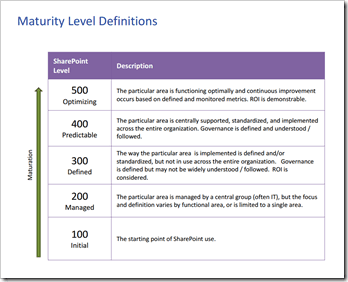Measuring Your Social Collaboration Progression
In a conversation with customer this week, they asked me how I thought their use of SharePoint, Yammer, and other social collaboration tools compared to other organizations I work with. Honestly, I don’t know how to answer that. Its largely an apples-versus-oranges comparison, as one company may use more advanced tools and be very social-tool-savvy, while another company may use more basic tools, but have those tools tightly aligned with their business processes and management scorecard. It made me think of the great work done by Sadalit Van Buren (@sadalit) a couple years back around the SharePoint Maturity Model (SPMM), and so I went looking for something similar to SPMM, designed for the broader social collaboration space.
One of the first search results pointed me toward the recently published Enterprise Social Collaboration Progression Model (June 2013) developed jointly by the University of Arizona Eller College of Management and Microsoft. In this 23-page whitepaper, the authors do a great job of outlining the maturity model for social collaboration in a way that very much aligns with the SPMM. In fact, I’d love to see Sadie update her model, maybe expanding her data with the output of this whitepaper to provide a more holistic view over structured (SharePoint) and unstructured (social) collaboration maturity.
 The UoA and Microsoft team define their research as follows: “This paper presents a progression model of the emerging social collaboration paradigm to
The UoA and Microsoft team define their research as follows: “This paper presents a progression model of the emerging social collaboration paradigm to
determine current states and future plans for instituting social collaboration strategies. The
framework is organized by six phases and an initial overview of divisional/functional applications
of enterprise social collaboration. A CEO or CIO can use the model as a general road map to
identify opportunities in entering or improving an organization’s use of social collaboration
technologies and methods to achieve greater communication efficiencies.
The progression model focuses on collaboration between employees, partners, suppliers, and
consumers, but does not include topics such as social marketing, brand awareness, sales, and non‐integrated partners.”
The authors define their 6 stages as:
- Basic, which is the use of traditional communication tools, such as email and basic document sharing, with limited infrastructure and informal (if any) processes in place.
- Standardized, where an organization has taken the first steps toward adopting social tools and practices, although not enterprise-wide.
- Rationalized, when an organization has standardized and documented the social tools that are used and supported across the company, with a defined strategy (or different strategies by business unit) and functional goals.
- Dynamic – Internal Integration, where an organization has linked their various social strategies to an overall enterprise strategy, has developed some degree of centralized oversight or management, and has begun to integrate social activities and measurements into business processes and systems.
- Dynamic – Holistic Integration, which involves internal and external integration of software and services, revolving around a centralized internal platform and high levels of customization to link social activities to specific tools and business processes, as well as initiatives to drive adoption and engagement (gamification).
- Dynamic – Innovative, which is the use of advanced social collaboration tools and techniques, beyond what is available and is used in the mainstream, to drive the creation of intellectual property and generate competitive advantage.
An overview of their maturity model can be found in the first image in this post, or in the summary diagram below:
After defining the characteristics, prerequisites, obstacles and impacts of each stage of their maturity model, the authors then go on to provide some guidance on applying their model for sales and marketing teams, product development, operations and distribution, customer support, and business support. While this “Where Do I Begin?” content is a nice add, it really just scrapes the surface of how a company should interpret their results and move forward on a strategy. I made similar comments around Sadie’s work on the SharePoint Maturity Model – its a great method for measuring and tracking the maturity of your SharePoint implementation, to help you better understand areas where you can improve and optimize, but the model and its outputs do not equal a SharePoint strategy in and of itself.
The intent of measuring your social collaboration (or SharePoint) maturity should be to get a more holistic view of where you are as an organization, and to present your leadership team and key influencers with talking points for improving and optimizing your strategy. As I stated at the beginning of this post, how companies rate themselves can be somewhat subjective – but while this type of maturity model can help normalize some definitions, how you define and execute your strategy for moving to the next level (if that is part of your strategy) might be very different from the strategies I apply within my organization.
For those who read my posts regularly, you’ve heard me paraphrase W. Edwards Deming repeatedly: you cannot optimize what you do not measure. Following a maturity model like this is a great way to get started in your measurements, to draw a line in the sand, and to begin to improve your social collaboration capabilities.







